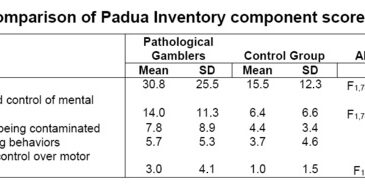Over the years, veteran readers of the WAGER may have discerned recurrent themes in pathological gambling research. One of the more prominent of these themes is the conception of disordered gambling as part of an obsessive-compulsive spectrum disorder. Broadly defined, an obsessive-compulsive spectrum disorder is an umbrella category that includes diagnoses such as substance abuse disorders, certain personality disorders, OCD, trichotillomania, Tourette’s syndrome, and eating disorders. The spectrum is defined on one end by impulsivity and on the other by compulsivity. Proponents of this theory maintain that pathological gambling should be included on this spectrum, citing common symptomatology, comorbidity, and pharmacologic response among the member disorders. Alex Blaszczynski, an Australian researcher, set out to specify the relationship between pathological gambling and obsessive-compulsive behavior (Blaszczynski, 1999). Using an experimental cohort of 40 DSM-IV diagnosed pathological gamblers and 40 controls who gambled, he measured obsessive-compulsive tendencies with the 60-item Padua Inventory. The Padua consists of four factors (listed below in the table). ANOVA analysis revealed significant differences between the experimental and control groups, primarily accounted for by two factors: a) Impaired control of mental activities and b) losing control over motor behaviors. Based on these findings, Blaszczynski proposes that future research focus on determining the precise location of pathological gambling on the impulsivity-compulsivity continuum.
Source: Blaszczynski, A. (1999). Pathological gambling and obsessive-compulsive spectrum disorders. Psychological Reports, 84, 107-133.
This public education project is funded, in part, by The Andrews Foundation and the National Center for Responsible Gaming.





